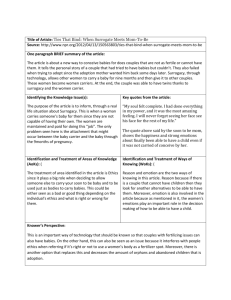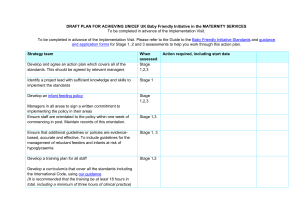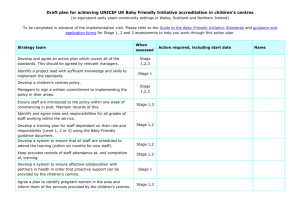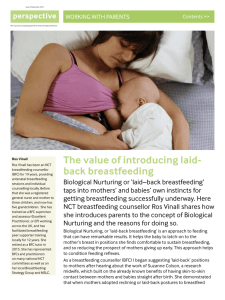Handout 3
advertisement
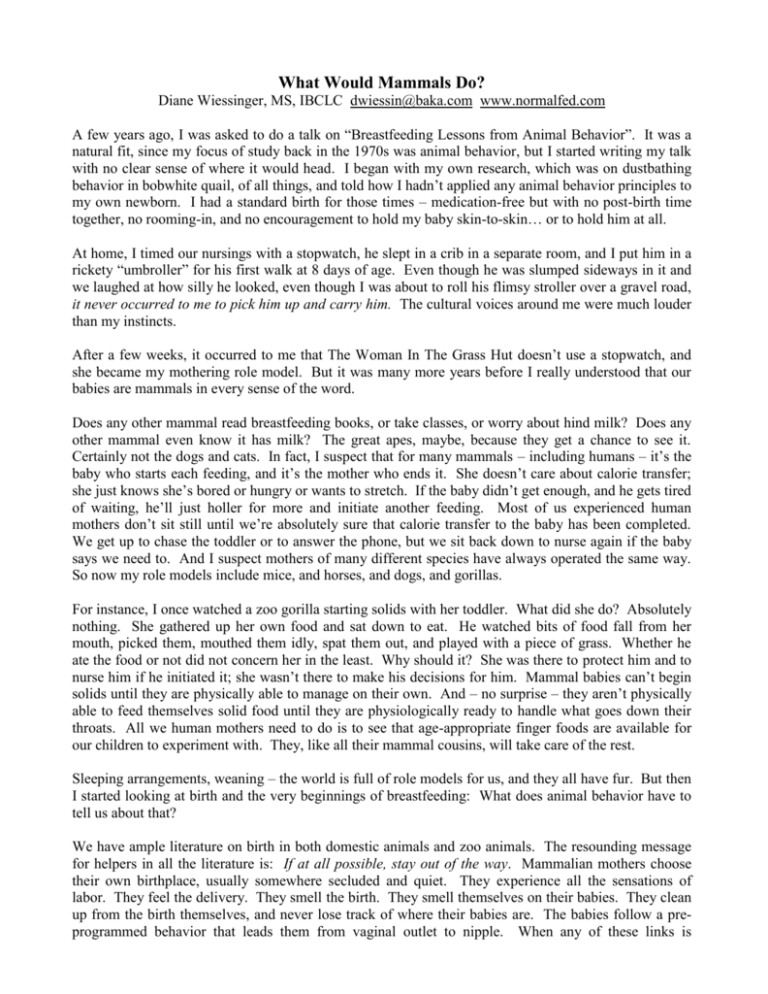
What Would Mammals Do? Diane Wiessinger, MS, IBCLC dwiessin@baka.com www.normalfed.com A few years ago, I was asked to do a talk on “Breastfeeding Lessons from Animal Behavior”. It was a natural fit, since my focus of study back in the 1970s was animal behavior, but I started writing my talk with no clear sense of where it would head. I began with my own research, which was on dustbathing behavior in bobwhite quail, of all things, and told how I hadn’t applied any animal behavior principles to my own newborn. I had a standard birth for those times – medication-free but with no post-birth time together, no rooming-in, and no encouragement to hold my baby skin-to-skin… or to hold him at all. At home, I timed our nursings with a stopwatch, he slept in a crib in a separate room, and I put him in a rickety “umbroller” for his first walk at 8 days of age. Even though he was slumped sideways in it and we laughed at how silly he looked, even though I was about to roll his flimsy stroller over a gravel road, it never occurred to me to pick him up and carry him. The cultural voices around me were much louder than my instincts. After a few weeks, it occurred to me that The Woman In The Grass Hut doesn’t use a stopwatch, and she became my mothering role model. But it was many more years before I really understood that our babies are mammals in every sense of the word. Does any other mammal read breastfeeding books, or take classes, or worry about hind milk? Does any other mammal even know it has milk? The great apes, maybe, because they get a chance to see it. Certainly not the dogs and cats. In fact, I suspect that for many mammals – including humans – it’s the baby who starts each feeding, and it’s the mother who ends it. She doesn’t care about calorie transfer; she just knows she’s bored or hungry or wants to stretch. If the baby didn’t get enough, and he gets tired of waiting, he’ll just holler for more and initiate another feeding. Most of us experienced human mothers don’t sit still until we’re absolutely sure that calorie transfer to the baby has been completed. We get up to chase the toddler or to answer the phone, but we sit back down to nurse again if the baby says we need to. And I suspect mothers of many different species have always operated the same way. So now my role models include mice, and horses, and dogs, and gorillas. For instance, I once watched a zoo gorilla starting solids with her toddler. What did she do? Absolutely nothing. She gathered up her own food and sat down to eat. He watched bits of food fall from her mouth, picked them, mouthed them idly, spat them out, and played with a piece of grass. Whether he ate the food or not did not concern her in the least. Why should it? She was there to protect him and to nurse him if he initiated it; she wasn’t there to make his decisions for him. Mammal babies can’t begin solids until they are physically able to manage on their own. And – no surprise – they aren’t physically able to feed themselves solid food until they are physiologically ready to handle what goes down their throats. All we human mothers need to do is to see that age-appropriate finger foods are available for our children to experiment with. They, like all their mammal cousins, will take care of the rest. Sleeping arrangements, weaning – the world is full of role models for us, and they all have fur. But then I started looking at birth and the very beginnings of breastfeeding: What does animal behavior have to tell us about that? We have ample literature on birth in both domestic animals and zoo animals. The resounding message for helpers in all the literature is: If at all possible, stay out of the way. Mammalian mothers choose their own birthplace, usually somewhere secluded and quiet. They experience all the sensations of labor. They feel the delivery. They smell the birth. They smell themselves on their babies. They clean up from the birth themselves, and never lose track of where their babies are. The babies follow a preprogrammed behavior that leads them from vaginal outlet to nipple. When any of these links is disrupted, there is a high likelihood that the mother will reject the baby, or that the baby will be too confused to complete his role. The lesson that shouted out to me from all the literature I read – a lesson that it took me 30 years to figure out – is that there’s very little information on mammalian infant feeding. IT’S ALL ABOUT THE BIRTH. Following a normal birth, infant feeding just… happens. Following an interventionist birth, the mother rejects the baby and there is no nursing at all, and there’s not much anyone can do about it. Our hospital births break every rule in the mammalian rule book of mother-baby necessities. The mother goes to a place that her body rebels against. (Some mothers have told me that the hospital was in fact their chosen birthplace and so they felt safe and relaxed there. Their minds may have felt safe there, but their bodies did not. How many of you have taken a long-desired vacation and found your bowel habits all disrupted? Your mind was having a great time; your body was nervous about being away from home.) She has medications that keep her from feeling the labor. She has no chance to smell the birth, or to smell herself on her baby, or to examine the goo that the birth produced. If the birth was surgical, she must take others’ word that this is her baby; there are absolutely no physiological landmarks for her to go by. The hospital-birthed baby usually doesn’t behave normally, which may affect how eagerly she connects with him. And he’s likely to have a tough time starting when his first experience is not his chest against his mother’s skin but a whole series of unexpected hands and procedures and separations. I suddenly realized that this culture has expected generations of women to raise the equivalent of foster children. Most of us manage, and we form a gradual and deliberate bond using our intellects – one that we didn’t form immediately and automatically using our instincts. But there are also women who bow to the pressures of mammalian behavior. Highly stressed by life circumstances, poorly bonded from the start, deprived of the healing connection of lactation, a mother is more likely to respond to her child with violence or rejection. The human mother who kills or abuses her baby is very likely following primal mammalian mandates that were set in motion in the hospital. Fortunately, our mammalian background can be overridden, of course, and the great majority of us do just that. Or do we? It’s a dark, dark corner of our maternal experiences that most of us haven’t visited, but perhaps our terrible births echo much longer and more widely than we like to think. Revisit your own births, and your own parenting experiences, and dig deeper than you have before. Is there a link between the quality of the birth and the quality of the bond? I don’t have answers; I never even thought to look until recently. But those basic mammalian mother urges – to reject any babies to whom we don’t feel we gave birth, to reject any babies that don’t look or act like “keepers,” to make the mothering choices any dog or deer or dormouse would make under the conditions to which we are subjected – those urges are surely there, whether we override them or not. My primary breastfeeding lesson from animal behavior? For over 20 years as a breastfeeding helper, I’ve been looking at the wrong end of the mother. The animal literature fairly shouted at me, “It’s The Birth, Stupid!” If I really want to help mothers to breastfeed, I need to start spending time connecting with the birth community, and helping them fight for more normal births. If we succeed there, most of the time breastfeeding will just… happen. Just as it always has. Some starting points for those of you who would like to read more: Buckley SJ. Gentle birth, gentle mothering. 2009. Celestial Arts, Berkeley. Gaskin IM. Ina May’s guide to childbirth. 2003. Bantam, NY. Hrdy SB. Mother nature: maternal instincts and how they shape the human species. Ballantine Books, NY. 1999. Mohrbacher N, Kendall-Tackett K. Breastfeeding made simple. New Harbinger Publications, Inc., Oakland, CA. 2010. Smith LJ. Impact of birthing practices on breastfeeding: protecting the mother and baby continuum, 2nd edition. Jones and Bartlett Publishers, Sudbury, MA. 2009. www.motherfriendly.org ©2011 Diane Wiessinger, MS, IBCLC www.normalfed.com






